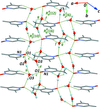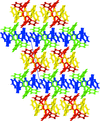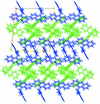issue contents
December 2016 issue

Cover illustration: Piroxicam is a non-steroidal anti-inflammatory drug classified as a BCS Class II drug due to its low aqueous solubility. Co-crystallization of an active pharmaceutical ingredient (API) and an FDA-approved counter-ion is a common technique employed to increase the solubility of the API. Two co-crystals of piroxicam and gentisic acid, one a 1:1 co-crystal and the second a solvated co-crystal that incorporates acetone into the crystal in a 1:1:1 molar ratio, have been reported. The third, reported here, is a 2:1 piroxicam:gentisic acid co-crystal, in which one of the piroxicam molecules is neutral and the other is a zwitterion. The two molecules exhibit different conformations in the crystal structure. In the zwitterionic form, there are two intramolecular N-H O hydrogen bonds, while in the neutral molecule there is only one intramolecular O-H
O hydrogen bonds, while in the neutral molecule there is only one intramolecular O-H O hydrogen bond. See: Horstman, Bertke, Woods & Kenis [Acta Cryst. (2016). E72, 1714-1717].
O hydrogen bond. See: Horstman, Bertke, Woods & Kenis [Acta Cryst. (2016). E72, 1714-1717].
research communications


































































Crystal structure of bis(3,5-dimethylpyridine-κN)bis(methanol-κO)bis(thiocyanato-κN)cobalt(II)




























 journal menu
journal menu
































































